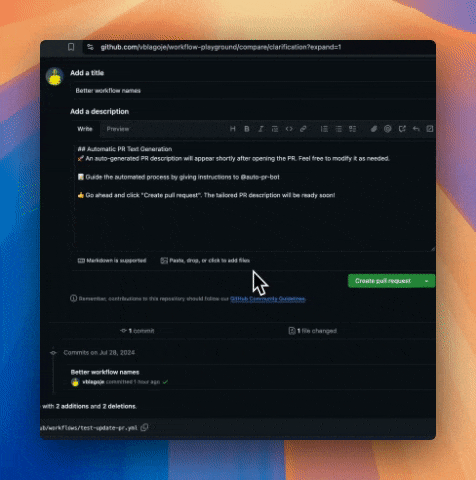Automatically generate comprehensive Reno release notes for your PR requests
Reno Auto is a GitHub Action designed to generate reno release notes using Large Language Models (LLMs) automatically. By default, it utilizes OpenAI's models, but it also supports integration with a variety of other LLM providers such as fireworks.ai, together.xyz, anyscale, octoai, etc., allowing users to select their preferred provider and LLMs to best suit their needs.
The minimum requirements to use this action with its default settings are:
- You have an
OPENAI_API_KEYset in your repository secrets. - You have given "Read and write permissions" to workflows in your repository:
- Settings -> Actions -> General -> Workflow Permissions: Select 'Read and write permissions' and Save
- Add a workflow to your repository to trigger this action when a new PR is opened. See the example below.
- (Optional) Use the example pull request template in your repository to create an initial PR description
Reno-auto can be used in two distinct scenarios, each with its own security implications and use cases:
This approach uses the pull_request_target event and is completely secure, allowing forks to make PRs.
name: Pull Request Reno Note Generator Workflow
on:
pull_request_target:
types: [opened]
jobs:
create-pr-release-note:
runs-on: ubuntu-latest
steps:
- name: Generate Release Note for this PR
uses: vblagoje/reno-auto@v1
id: reno-auto-step
with:
openai_api_key: ${{ secrets.OPENAI_API_KEY }}
- name: Create PR comment
uses: peter-evans/create-or-update-comment@v4
with:
issue-number: ${{github.event.pull_request.number}}
body: |
We use reno release [notes](https://docs.openstack.org/reno/latest/) to describe the code changes in this PR. Follow these steps:
1. Install reno via `pip install reno` (only once per virtual environment)
2. Run this command in your terminal from the project root:
```
reno new ${{steps.reno-auto-step.outputs.file-name}}
```
3. This command will generate a new release note file in the `releasenotes/notes` directory.
Paste the following release note text into that file:
```
${{steps.reno-auto-step.outputs.note}}
```
4. Review the release note text, adjust if needed, and save the file.
5. Add this file to your commit and push it to the branch.Pros:
- Completely secure, even for PRs from forks
- No risk of exposing secrets or running malicious code
- Suitable for public repositories with many contributors
Cons:
- Doesn't automatically commit the release note to the PR
- Requires manual action from the PR author to add the release note
Here is an example PR that uses this approach:
This approach uses the pull_request event and is suitable for environments where PRs from forks need approval.
name: Create Reno release note and commit it
on:
pull_request:
types: [opened]
jobs:
create-pr-release-note:
runs-on: ubuntu-latest
steps:
- name: Checkout Repository (even forks) to add reno note commit to it
uses: actions/checkout@v4
with:
fetch-depth: 0
ref: ${{github.event.pull_request.head.ref}}
repository: ${{github.event.pull_request.head.repo.full_name}}
- name: Generate Release Note for this PR
uses: vblagoje/reno-auto@v1
id: reno-auto-step
with:
openai_api_key: ${{ secrets.OPENAI_API_KEY }}
- name: Create PR release note and commit it to the branch
uses: vblagoje/create-or-update-release-note@v2
with:
note-name: ${{steps.reno-auto-step.outputs.file-name}}
note-content: ${{steps.reno-auto-step.outputs.note}}Pros:
- Automatically commits the release note to the PR branch
- Streamlined process for contributors
- Suitable for repositories with trusted contributors or internal teams
Cons:
- Potential security risk if used with untrusted forks
- Requires careful management of PR approvals and permissions
- Not recommended for public repositories with unknown contributors
Here is an example PR that uses this approach:
For public repositories or projects with many unknown contributors, use the secure approach with pull_request_target. For private repositories, internal projects, or situations where all contributors are trusted, the second approach with pull_request can be more convenient.
Always consider your project's specific needs and security requirements when choosing between these approaches.
-
github_tokenRequired GITHUB_TOKEN or a repository-scoped Personal Access Token (PAT), defaulting to the GitHub token provided by the GitHub Actions runner. It is essential for invoking the GitHub API REST service to retrieve Pull Request details. Using GITHUB_TOKEN permits actions to access both public and private repositories, helping to bypass rate limits imposed by the GitHub API. -
openai_api_keyRequired The OpenAI API key for authentication. Note that this key could be from other LLM providers as well. -
openai_base_urlOptional The base URL for the OpenAI API. Using this input one can use different LLM providers (e.g. fireworks.ai, together.xyz, anyscale, octoai etc.) Defaults to https://api.openai.com/v1 -
github_repositoryOptional The GitHub repository where the pull request is made. Defaults to the current repository. -
base_branchOptional The base (target) branch in the pull request. Defaults to the base branch of the current PR. -
head_branchOptional The head (source) branch in the pull request. Defaults to the head branch of the current PR. -
generation_modelOptional LLM to use for reno release note text generation. Defaults to gpt-4o from OpenAI. -
function_calling_modelOptional LLM to use for function calling (service parameter resolution, output formatting etc). Defaults to gpt-3.5-turbo from OpenAI. -
system_promptOptional System message/prompt to help the model generate reno release note (prompt text or URL where prompt text can be found). Defaults to https://bit.ly/reno_release_note_system_prompt_v2
Using reno-auto in conjunction with fetching code from untrusted PR forks (via actions/checkout) poses a significant security risk, especially when used with the pull_request_target event.
For example, another Github Action create-or-update-release-note can create a release note commit directly in the PR branch. However, it needs to check out the code from the fork, which can have significant security risks. Use this approach for trusted PRs only (e.g., PRs from your own repository).
For more detailed information on these security considerations, refer to:
- GitHub Actions documentation on pull_request_target
- GitHub Security Lab article: "Keeping your GitHub Actions and workflows secure: Preventing pwn requests"
If you have ideas for enhancing Reno Auto, or if you encounter a bug, we encourage you to contribute by opening an issue or a pull request.
The core of this GitHub Action is built on top of Docker image of the vblagoje/openapi-rag-service project.
Therefore, for contributions beyond minor edits to the action.yml or README.md, please direct your pull requests to
the vblagoje/openapi-rag-service GitHub repository.
This project is licensed under Apache 2.0 License.


